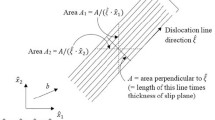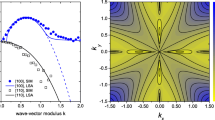Abstract
Based on the principle given in nonlinear diffusion-reaction dynamics, a new dynamic model for dislocation patterning is proposed by introducing a relaxation time to the relation between dislocation density and dislocation flux. The so-called chemical potential like quantities, which appear in the model can be derived from variation principle for free energy functional of dislocated media, where the free energy density function is expessed in terms of not only the dislocation density itself but also their spatial gradients. The linear stability analysis on the governing equations of a simple dislocation density shows that there exists an intrinsic wave number leading to bifurcation of space structure of dislocation density. At the same time, the numerical results also demonstrate the coexistence and transition between different dislocation patterns.
Similar content being viewed by others
References
Qian Zhengfang, Duan Zhuping, Wang Wenbiao. Advances in dislocation patters formation.Advances in Mechanics, 1992, 23(3): 92 (in Chinese)
Kubin LP, Estrin Y, Canova G. In: Walgraef D, Ghonien N, eds. Pattens, Defects and Material Instabilities. Kluwer Acad Pub., 1990. 277–302
Frenkel J, Kontorova T..Phys Z, Sov, 1938, 13: 1
Peierls R E.Proc. Roy. Soc., 1940, 52: 23
Nabarro F R N.Proc. Roy. Soc., 1947, 59: 256
Holt D L. Dislocation cell formation in metals.J Appl Phys, 1970, 41: 3197–3201
Winter A T.Phil. Mag., 1974, 30: 719
Walgraef D, Aifantis E C. Dislocation patterning in fatigued metals as a results of dynamical instabilities.J Appl Phys, 1985, 58: 688–691
Kratochvil J. Dislocation pattern formation in metals.Revue Phys. Appl., 1988, 23:419–429
Kubin L P, Lepinoux J. The Dynamic Oganization of Dislocation Structures. In: Kettunen PO, Lepistö TK, Lehtonen ME, eds. Strength of Metals and Alloys (ICSMA-8), Vol.1. Oxfod: Pergaman Press, 1988: 35–59
Martin G, Kubin L. Nonlinear Phenomena in Material Sciences. Aedermannsdorf, CH: Trans. Tech. Publications, 1992.
Crank J.J. Polymer Sci., 1953, 1:151
Cho Ung-In and Eu B C. Ayperbolic reaction-diffusion equations and chemical oscillations in the Brusselator.Physica, 1993, D68: 351–363
Author information
Authors and Affiliations
Additional information
The project supported by the National Natural Science Foundation of China, Grant No.19392300
Rights and permissions
About this article
Cite this article
Zhuping, D., Wenbiao, W., Qingrong, Z. et al. A New dynamic model for study of dislocation pattern formation. Acta Mech Sinica 12, 200–212 (1996). https://doi.org/10.1007/BF02486807
Received:
Revised:
Issue Date:
DOI: https://doi.org/10.1007/BF02486807




